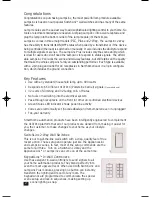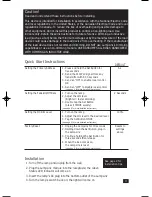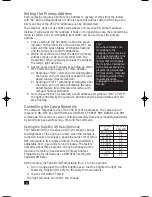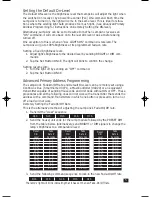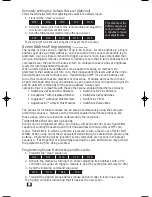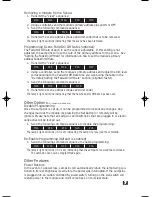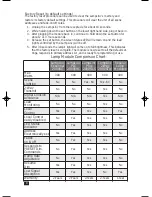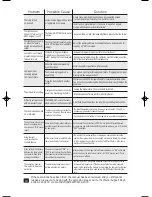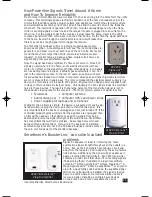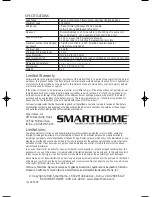
How Powerline Signals Travel Around A Home
and How To Improve Reliability
Most homes in North America have two lines of 120 volts coming into the home from the utility
company. This split-single phase electricity is divided out at the home’s breaker box into the
circuits that feed light switches, plug-in outlets, and appliances. Half of the electricity outlets
and wall switches are fed by one of the 120-volt lines and the second 120-volt line feeds the
other half. The intermittent operation of PLC/X10 modules usually happens when the trans-
mitter is sending signals on one line and the receiver module is plugged into an outlet on the
other line. For the signals to get to the receiver, it must leave the home, travel to the utility
company transformer then come back in on the other AC line. By the time the signal gets back
to the home, travels through the electrical meter and circuit breaker box,
there may not be enough signal left to trigger the module.
The first order of business will be to install a coupler-repeater, also
known as amplifier. A coupler-repeater will ‘see’ the incoming signal, re-
generate it, and blast it out over both lines of the 120 volts. We recom-
mend that any home larger than 3000 square feet install a coupler-
repeater. In smaller homes, a passive phase coupler also known as a
signal bridge may give satisfactory results.
Once the signal has been amplified, it’s time to preserve it. Since PLC
signals go everywhere in the home, some electrical devices will have
more of an effect on the signal strength than other devices. PLC signals
are like water pressure in pipes, it actually goes everywhere it can, not
just to the receiving module. In the last 20 years, an explosion of elec-
trical devices has invaded our homes. Computers, video gear, and fancy high-end electronics
are more present than in years past. The more complicated the electrical power supply is in a
device, the more likely it is to absorb PLC signals. Engineers who design power supplies build
in traps to filter out and kill electrical noise. Unfortunately, the PLC signals looks like electrical
noise to these devices. The result is that a large percent of the transmitted signal is lost to
these devices leaving less for the receivers. The most common sources of signal loss are:
• Televisions
• Computer systems
• Audio/Video gear • Computer UPS's and power strips
• Power supplies for laptops and cell phones
Testing for the problem is simple. If a device is suspected of causing sig-
nal absorption, unplug the device and then re-transmit the signal. It is
very important that the device is unplugged and not just turned off! If the
controlled product begins working after the appliance is unplugged, then
a filter will be needed on that device to keep PLC signals from being
absorbed and raise the signal strength of the entire home. Smarthome
has many filters that will fix the problem. An average home will need
between three and five filters. If you are in the business of installing
automation systems and not in the ‘call-back’ business, include some of
these in your bid as part of the standard package.
Smarthome’s BoosterLinc
™
can solve localized
problems
SignaLinc Repeater is ideal for improving the home
automation signal strength throughout all the outlets in a
home. But, as the PLC signals travel down a circuit and
away from the repeater, it will weaken by the same factors
listed above. Additionally, the signal will get weaker as it
passes installed PLC transmitters. Each PLC transmitter
contains a tuned circuit that when it's not sending signals
it's absorbing them! In addition to plug-in transmitters,
LampLinc™ 2-Way, SwitchLincs™ 2-Ways, ToggleLinc™ 2-
Ways, ApplianceLinc™ 2-Ways, KeypadLincs™, or any mod-
ule with 2-way abilities will load down the available signal.
With so many transmitters installed, the signal is loaded
down to a point where some modules will be unable to
receive a signal. Installing a multiple 2-way devices
on one branch circuit may necessitate the use of
local amplifier like Smarthome's BoosterLinc
.
11
#4827 BoosterLinc
TM
Plug-In Amplifier
#4826B
SignaLinc
TM
Repeater
#1626 FilterLinc
TM
Plug-In Filter
LampLink Plus& PLC for web (Mar04).qxd 3/15/2004 9:59 AM Page 11


